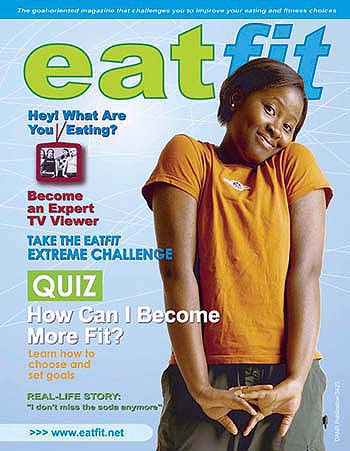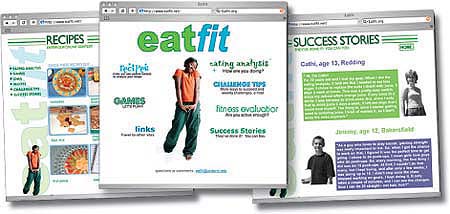All Issues
Eatfit guides adolescents to improve health and fitness
Publication Information
California Agriculture 58(1):10-11.
Published January 01, 2004
PDF | Citation | Permissions
Full text
A hip new program called “EatFit” is helping adolescents to change their eating and exercising habits using “guided goal-setting,” a new tool developed by UC nutrition specialists and advisors.
EatFit includes a teen-oriented magazine, interactive Web site and school curriculum designed for 11- to 15-year-olds. The message is one of dietary moderation and common-sense fitness, a critical component of addressing the growing prevalence of obesity among youth and adults ( see page 12 ). Instead of setting their own goals, which is usually unrealistic for middle-school-age children, the program guides them toward achievable lifestyle and habit changes.
About 120 middle schools are using the curriculum, as well as after-school programs and camps, with an estimated 15,000 children participating in 2003.
One evaluation of the program, to be published in the Journal of Nutrition Education and Behavior (January-February 2004), found that 74% and 79% of 8th graders participating in EatFit made at least one positive change in their dietary and physical activity behaviors, respectively.
To develop the materials, UC researchers conducted interviews with children and their teachers.
“We found out that we needed to be hip,” says Marilyn Townsend, UC Davis nutrition specialist and leader of the EatFit group. “That's why we went with the magazine format for kids. They also told us that they wanted a computer component.”
The 20-page magazine and workbook incorporates elements you might find in Seventeen or Teen People: “fab features,” quizzes, lively colors, skateboards, food and irreverent facial expressions.
The Web site, www.eatfit.net , includes recipes and success stories that provide fun ways to gather information and get motivated, plus an innovative online analysis to help teens evaluate how they currently eat and determine healthy goals. Users type in the foods they ate in a 24-hour period. The site helps narrow down specifics on types of food and serving sizes, then gives a brief analysis and offers two goals for making the diet healthier. The teen selects one, and then is given a selection of small habit changes to help achieve that goal.
“We know that eating too much refined sugar is an issue with kids, and that girls aren't getting enough calcium,” says Marcel Horowitz, a researcher on the project. “We present those as goal options. They may not choose them, but once they learn the process and experience success, they might be willing to look at another area in their diets that would be beneficial to change.”
The researchers used goal options in the Web site that students themselves suggested. “We asked kids, ‘If you were going to increase calcium, how would you go about it?’” Townsend says. As a result, users may choose to drink the milk leftover in their cereal bowls three times per week as one goal option.
“Instead of saying ‘drink more milk,’ we made each minor goal specific, challenging and something they can do right away,” Townsend says. “If we let the kids set their own goals, they tended to be too general, too easy or too difficult.”
Developed by Horowitz and recent UC Davis Ph.D. graduate Mical Shilts, the EatFit magazine provides analyses for four areas of physical activity: aerobic, stretching, strength and lifestyle. Each has major and minor goal options for students to select, depending on their interests.
“The lifestyle area is where we hope to have the greatest impact on obesity,” Horowitz says. “We offer options for things people can do consistently that don't require the motivation necessary to participate in organized fitness sessions.”
The idea is to make physical activity a part of everyday life.
“We teach them they don't need to find a parking place close to the door,” Horowitz says. “Instead of riding the elevator, they can take the stairs. Just sitting in the garden pulling weeds uses more calories than watching television.”
The nine-lesson classroom curriculum includes topics such as reading food labels, eating at fast-food restaurants and understanding the media's influence. Students track their eating and fitness progress, and receive motivating incentives such as raffle tickets and prizes. The lessons are correlated to California Department of Education standards.
Teachers can obtain the curriculum at http://anrcatalog.ucdavis.edu or UC Cooperative Extension offices, and receive training and support from UC nutrition advisors. For information, call (530) 754 8051 or go to http://groups.ucanr.org/efnepyouth/index.cfm .
Sustainable ag lectures online
A major lecture series at UC Davis, “The Science of Sustainable Agriculture: Measuring the Immeasurable,” which included 17 internationally recognized experts on sustainability in relation to agriculture, the environment and society, is available online.
Sustainable agriculture has stimulated public debate about where food comes from and the interplay of food production, food security ( see pages 12 , 18 ) and the protection of human and natural resources. “University research and education play a key role in assessing and increasing the sustainability of the food and agricultural systems,” said Neal Van Alfen, dean of the UC Davis College of Agriculture and Environmental Studies, a major funder of the series.
The series began last April and continued every Friday afternoon through the fall. Speakers included experts in nutrition, biodiversity, climate change and organic farming from around the nation and world.
For more information, go to: www.sarep.uc-davis.edu/seminar/ .






